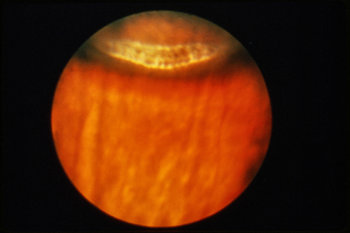

GFAP, RPE65, pan-CK, and CK18 immunostaining of the retinal lattice degeneration whole mount specimen in Case 1. The purpose of this present study was to perform RPE65 and CK immunostaining on retinal tissues containing specimens of retinal lattice degenerative lesions collected during vitreous surgery, and to report our novel findings on the pathogenesis of retinal lattice degeneration. Cytokeratin (CK) is one of the intermediate filaments that form the cytoskeleton of epithelial cells, and it is specifically expressed in the retinal pigment epithelium. Retinal pigment epithelium-specific protein 65 kDa (RPE65) is a specific marker of RPE cells, and is reportedly involved in retinoid metabolism, one of the functions of retinal pigment epithelial cells. However, to the best of our knowledge, there have been no previous studies investigating whether the markers of RPE cells are expressed in the lesions of retinal lattice degeneration. These findings suggest that the migration and proliferation of RPE cells may be involved in the pathogenesis of retinal lattice degeneration. Although previous studies have reported the migration of macrophages with melanin pigment, no changes in the choroid are usually observed. Moreover, the degenerative lesion is often pigmented, and the thickness of the retinal pigment epithelium (RPE) corresponding to the degenerated area is simultaneously uneven and may be partially lost. Numerous reports have indicated that, histopathologically, the degenerated area of retinal lattice degeneration is thinned and devoid of photoreceptors, and is replaced by glial cells in all retinal layers. Retinal lattice degeneration is thought to be involved in the development of rhegmatogenous retinal detachment in approximately 30% of the cases, making this degeneration clinically very important. Retinal lattice degeneration is a type of vitreoretinal degeneration associated with atrophic lesions of the retina and overlaying vitreous liquefaction observed in the equatorial region of the ocular fundus. Peripheral retinal degeneration is characterized by various types of lesions, such as those associated with lattice degeneration, cobblestone degeneration, and cystoid degeneration. Our findings suggest that migration, proliferation, and differentiation of RPE cells might be involved in the repair of retinal lattice degeneration. In a monkey retina used as the control specimen of a normal healthy retina, no RPE65 or pan-CK staining was observed in the neural retina.

However, no obvious CK18 staining was observed. In the degenerative lesion specimens, GFAP staining was observed in the center, RPE65 staining was observed in the slightly peripheral region, and pan-CK staining was observed in all areas. Hematoxylin staining showed no nuclei in the center of the degenerative lesion, thus suggesting the possibility of the occurrence of apoptosis. In the obtained specimens, both whole mounts and horizontal section slices were prepared, and immunostaining was then performed with hematoxylin and antibodies against glial fibrillary acidic protein (GFAP), RPE-specific protein 65 kDa (RPE65), pan-cytokeratin (pan-CK), and CK18. In two cases of retinal detachment with a large tear that underwent vitreous surgery, retinal lattice degeneration tissue specimens were collected during surgery.

Here we performed an immunohistological study of tissue sections of human peripheral retinal lattice degeneration to investigate if retinal pigment epithelium (RPE) cells are involved in the pathogenesis of this condition. Lattice degeneration involves thinning of the retina that occurs over time.


 0 kommentar(er)
0 kommentar(er)
